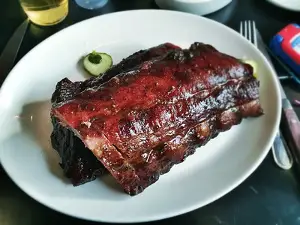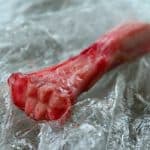
If a dog’s prayers were answered, bones would rain from the sky, says an old Turkish proverb. Well, that would be unpleasant for the rest of us, but, hey, many dog owners would do anything to make their pets happy.
And since the skies do not grant that incredible bounty, most people take it upon themselves to provide dogs with their favorite treat ever.
In a previous post I looked at bone marrow broth for dogs.
And in this post I ask, if these bones are so wonderful, why do some dogs vomit after eating them?
Let me first of all talk about what exactly a marrow bone is…
What are marrow bones?
Technically, all bones contain marrow, but in the dog world, the term marrow bones refers mainly to the long bones in a cow’s legs. The best is the femur, the bone in the upper leg or thigh, which is large enough to keep the dog entertained for a long time and has a lot of marrow inside. The marrow is a spongy tissue high in nutrients, such as proteins, minerals and vitamins, as well as collagen.
Why is my dog vomiting after eating a marrow bone?
Nothing makes a dog happier than chewing on a large bone, but in many cases, there’s a high price to pay for overindulging. A lot of dog owners complain that their dogs end up with an upset stomach after chewing too much on a bone. The most common symptoms are vomiting and diarrhea, which will make the dog (and the owner) miserable.
Experts say that, for all its nutritional value, bone marrow contains too much fat and this is the main reason it makes the dog sick. While in most cases, the condition will resolve itself in a couple of days, pet owners need to be aware of the fact that too many fats can cause pancreatitis, an inflammation of the pancreas which left untreated can prove fatal.
Another possible reason marrow bones make the animal sick is that a dog’s vigorous chewing might cause the bone to splinter, which may lead to small bone fragments gathering in the stomach. If the dog’s stomach is unable to digest those bone fragments two things can happen.
The bone fragments might go up and the dog will vomit, or continue their journey through the intestines, sometimes causing lacerations and bloody diarrhea.
What should I do?
If your dog has a sensitive stomach, giving him recreational marrow bones might not be such a good idea.
If your dog starts vomiting a few hours or a day after chewing on a marrow bone, try to assess the animal’s overall condition, to make sure the problem was caused by the juicy treat and not something else.
As in all cases of dogs with an upset stomach, the first step is to put the dog on a bland diet, consisting mostly of rice, to which you can later add pieces of boiled chicken meat.
Give only a small quantity of food and see if the dog manages to hold it down. If he vomits again better wait for a couple of hours before offering another serving.
Always keep in mind that vomiting and diarrhea cause dehydration so try to give your dog small quantities of water every 15 minutes. If you see signs of severe dehydration, add some Pedialyte which is an electrolyte solution for children into the dog’s drinking water.
If the dog becomes constipated or there’s blood in the stool, it’s best to see the vet right away as perforated intestines can cause a life-threatening infection.
How many marrow bones should a dog have?
Marrow bones are good for a dog’s health, both physical and mental, as they satisfy the animal’s natural instinct to chew. This does not mean your dog should receive large marrow bones on a regular basis. You’d better keep them as a treat and offer just two marrow bones a week, a few days apart.
You want to avoid feeding your dog too many fats and there’s also the question of the animal getting too many calories, which can lead to obesity.
My dog has a marrow bone stuck on his jaw, what should I do?
Marrow bones can occasionally cost a dog a tooth or two, which is painful for the animal and costly for the human paying the vet’s bill.
However, the most terrifying problem caused by these tasty treats is when a marrow bone gets stuck on the poor dog’s jaw. The bone can get caught behind the dog’s canines, the fangs, and when the lips swell it’s very hard to get it off.
It’s a very scary situation and potentially fatal if the dog cannot breathe. In most cases, the dog will be in obvious distress and this will make the owner panic as well.
You may try to see if you can get the bone off but you have to be extremely gentle. Pulling too hard on the stuck piece can break a few of the dog’s teeth without even solving the problem.
The best thing to do is call the vet and go in for an emergency consultation. Vets are more experienced when it comes to dislodging the bone without breaking the dog’s teeth. Also the vet might administer an anaesthetic to keep the dog quiet during the procedure.
If the bone refuses to budge, the vet will probably just saw it off. It’s not as scary as it sounds as vets use just a file to cut through the bone and this part only takes a couple of minutes.
Are bone marrow bones bad for a dog’s teeth?
There are pros and cons on the effects chewing on large marrow bones has on the dog’s teeth. As already pointed out, occasionally, this can result in chipped or indeed broken teeth, causing the dog a lot of pain.
On the other, chewing on bones is good for a dog’s overall oral health. It’s a very efficient, and natural, way to clean a dog’s teeth.
The act of chewing eliminates bacteria and food fragments stuck between the teeth, fights against plaque deposits, bad breath and gum disease. At the same time, chewing strengthens a dog’s jaw muscles.
If your dog has already lost a tooth on marrow bones, you might want to give him a more manageable treat, like pig or cow ears. Not quite as tasty, but good enough.
Are marrow bones dangerous for dogs?
To sum it up, yes, there are certain risks associated with marrow bones. They have a high fat-content which might cause an upset stomach or even more serious health issue, such as pancreatitis. However, if given with moderation, no more than twice a week a healthy animal won’t have any problem.
To prevent accidents, like a piece of bone getting stuck on a jaw, it’s best to keep an eye on the dog while he’s having the time of his life working his way to the yummy marrow.
At the same time, it’s best to take the bone away once the dog is done with the marrow. Remember that as the bone dries up it tends to become bore brittle and there is a risk it can splinter. Be very careful as splinters can cause damages to the trachea and esophagus, as well as internal bleeding.
This is also the reason why you should never serve a dog cooked bones. Any type of cooking makes the bone brittle, so if you’ve just prepared some bone broth for your family, throw the bone away rather than giving it to your pet.
You will find many articles quoting vets who say marrow bones are not good for dogs, but keep in mind that these experts routinely suggest giving your pet commercially-available bone substitutes, some of them edible and some made of plastic or rubber. Be wary of those trying to sell you something!
Why are marrow bones good for dogs?
Even taking into account the inevitable risks, marrow bones provide many health benefits.
Marrow bones are natural and completely unprocessed. If you buy them from your local butcher keep them in the freezer.
Raw bones are packed with proteins, minerals such as calcium and fatty acids to support strong bones and contribute to brain function.
The collagen in the bone marrow is great for keeping a dog’s joints healthy, preventing arthritis, which is a common problem in dogs.
The amino acids, calcium and phosphorus in marrow bones help support the dog’s digestive system.
Marrow bones are good for the dog’s dental hygiene. It’s much easier to solve this problem naturally than trying to brush your dog’s teeth.
It’s not just gluttony, dogs find entertainment in chewing large bones. Getting to the marrow is a challenge, a puzzle they need to solve.
If a dog has a bone to chew on he won’t try to satisfy his natural instincts by destroying your shoes or the furniture legs.
You can use marrow bones as a super reward when you’re training the dog.
There are certain risks associated with marrow bones, but the benefits outweigh the potential dangers. Give your dog a marrow bone once or twice a week and let him feast on it as nature intended. As with everything in life, moderation is key!
Photo Credits
¹ Photo by Christos Petrou on Flickr





